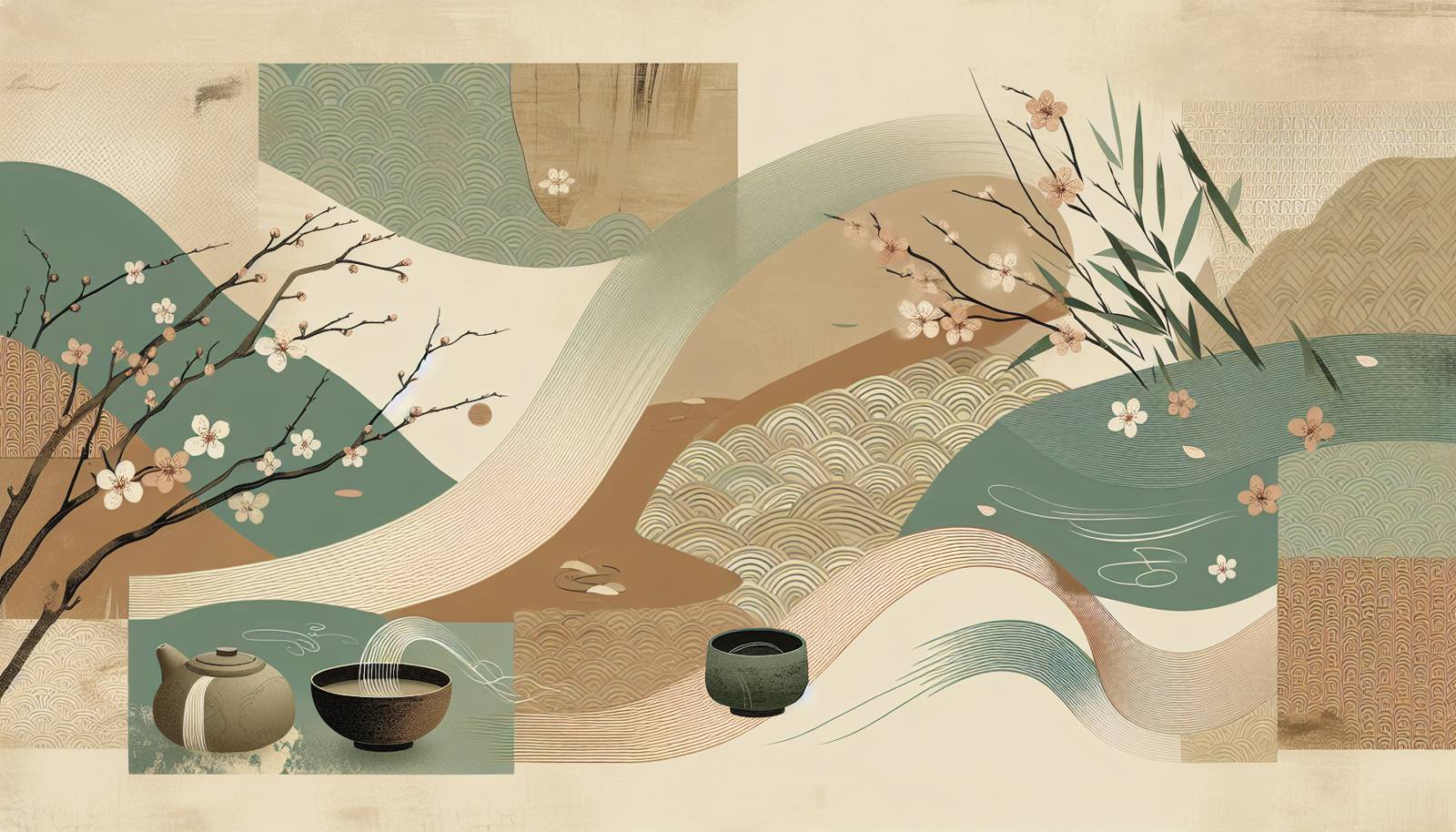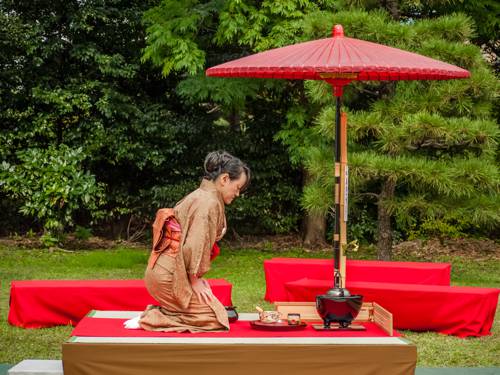
FAQ About Influence of Japanese Tea Ceremony on Modern Practices

What is the Japanese tea ceremony?
The Japanese tea ceremony, also known as chanoyu, sado, or chado, is a traditional ritualistic way of preparing and drinking tea. Originating from Zen Buddhism, it emphasizes harmony, respect, purity, and tranquility. The ceremony is not merely about drinking tea but is a spiritual process that incorporates aesthetics and philosophy.

How has the Japanese tea ceremony influenced modern mindfulness practices?
The Japanese tea ceremony has significantly influenced modern mindfulness practices by promoting presence and deliberate attention to each action. It encourages slowing down and focusing on the present moment, which aligns with mindfulness principles. The quiet, meditative nature of the ceremony allows participants to become fully aware of their surroundings and actions, serving as an inspiration for mindfulness techniques today.

What elements of the Japanese tea ceremony have been adopted into contemporary design?
Contemporary design often incorporates elements from the Japanese tea ceremony, such as minimalism, natural materials, and a focus on harmony and tranquility. The aesthetics of simplicity and subtle beauty, known as wabi-sabi, are reflected in modern architecture and interior designs that prioritize serene and uncluttered spaces.

In what ways has the Japanese tea ceremony influenced global hospitality practices?
The Japanese tea ceremony has influenced global hospitality by emphasizing meticulous attention to detail, a heartfelt welcome, and the idea of creating a tailored experience for guests. This cultural influence can be seen in personalized customer service and the emphasis on creating harmonious environments in hotels and restaurants worldwide.

How does the philosophy of the Japanese tea ceremony compare to that of Western tea traditions?
While Western tea traditions often focus on social interaction and leisure, the Japanese tea ceremony is deeply rooted in Zen Buddhism and focuses on spiritual and philosophical aspects. It emphasizes the art of preparation and meditation, aiming for inner peace and harmony. Western practices are generally more informal and geared towards communication.

Are there modern art forms influenced by the Japanese tea ceremony?
Yes, modern art forms, including installations, ceramics, and performance art, have been influenced by the Japanese tea ceremony. Artists often draw on its principles of simplicity, natural beauty, and the interplay of form and function. This influence is seen in minimalist art and works that emphasize process over final product.

Can aspects of the Japanese tea ceremony be seen in contemporary culinary practices?
Contemporary culinary practices have adopted aspects of the Japanese tea ceremony, especially the emphasis on seasonal and natural ingredients, presentation that respects the food, and the mindfulness involved in dining. The appreciation for subtle flavors and textures is a notable influence in modern gastronomy.

What is the significance of aesthetics in the Japanese tea ceremony?
Aesthetics play a crucial role in the Japanese tea ceremony, emphasizing simplicity, natural beauty, and the concept of wabi-sabi—finding beauty in imperfection. Every element, from the selection of utensils to the design of the tea room, reflects these aesthetics. This focus inspires appreciation for subtle elegance and has influenced various modern artistic and design practices.

How have Japanese tea ceremonies impacted wellness and self-care trends?
Japanese tea ceremonies have impacted wellness and self-care trends by promoting the idea of taking time for oneself, focusing on the present, and creating a tranquil environment. These aspects align with current wellness philosophies that emphasize mindfulness, relaxation, and personal space, inspiring various self-care rituals and products today.

What cultural values are communicated through the Japanese tea ceremony?
The Japanese tea ceremony communicates values such as harmony, respect, purity, and tranquility, which are foundational aspects of Japanese culture. These values are not only reflected in the ceremony itself but also permeate other aspects of Japanese lifestyle and interaction, influencing global perceptions of Japanese culture.

In what ways has the Japanese tea ceremony influenced modern architecture?
Modern architecture has been influenced by the Japanese tea ceremony through the adoption of minimalist design, use of natural materials, and emphasis on creating serene, balanced spaces. The concept of integrating the building with its environment, seen in traditional tea houses, echoes in today's sustainable and eco-friendly architectural practices.

What is the role of ritual in the Japanese tea ceremony?
Ritual plays a central role in the Japanese tea ceremony, structuring every aspect from the preparation to the serving of tea. This ritualization of actions promotes mindfulness, precision, and respect among participants. It has influenced how rituals and routines are perceived and implemented in various modern practices, including self-care and personal improvement disciplines.

How are Japanese tea gardens integrated into contemporary landscape design?
Japanese tea gardens, with their meticulous layout and focus on natural beauty, have influenced contemporary landscape design by highlighting elements like simplicity, balance, and integration with nature. Modern gardens often seek to incorporate these principles to create tranquil, meditative outdoor spaces that encourage relaxation and reflection.

Is the meditative aspect of the Japanese tea ceremony applicable in modern life?
Yes, the meditative aspect of the Japanese tea ceremony is applicable in modern life as it provides a way to pause and center oneself amidst the busyness of everyday activities. This meditative focus can be integrated into daily routines, offering moments of serenity and mindful awareness.

How does the Japanese tea ceremony influence modern social etiquette?
The Japanese tea ceremony influences modern social etiquette by instilling a sense of humility, respect, and mindfulness in social interactions. Participants learn to appreciate silence, subtle gestures, and the importance of being present, which can enhance interpersonal relationships and communication in today's global society.

What materials from the Japanese tea ceremony are incorporated into modern crafts?
Traditional materials such as bamboo, ceramics, and textiles used in the Japanese tea ceremony have found their way into modern crafts and design items, valued for their natural qualities and aesthetic appeal. Artisans often incorporate these materials into their work, drawing on the ceremony's emphasis on beauty and craftsmanship.

In what ways have sustainable practices within the Japanese tea ceremony inspired modern environmental movements?
The Japanese tea ceremony emphasizes sustainability through its use of natural materials, seasonal elements, and minimal waste. These practices have inspired modern environmental movements focused on sustainability and resource conservation, promoting ecological awareness and responsibility in design and lifestyle choices.

Why is the concept of <i>wabi-sabi</i> important in the Japanese tea ceremony?
The concept of wabi-sabi is important in the Japanese tea ceremony as it celebrates the beauty of imperfection and the natural cycle of growth and decay. This philosophy encourages an appreciation for the transient nature of beauty, influencing contemporary art, culture, and design by valuing simplicity and authenticity.

Can the Japanese tea ceremony's principles be integrated into digital spaces?
The principles of the Japanese tea ceremony, such as mindfulness and simplicity, can be integrated into digital spaces by creating user experiences that promote focus, reduce clutter, and enhance digital well-being. These concepts guide the development of interfaces and interactions that prioritize user engagement and satisfaction.

How has the Japanese tea ceremony influenced contemporary event planning?
The Japanese tea ceremony has influenced contemporary event planning by encouraging a focus on the guest experience, attention to detail, and creating moments of connection and mindfulness. Planners often draw on these elements to craft thoughtful and immersive events that leave lasting impressions on participants.
